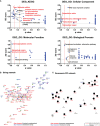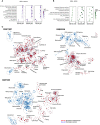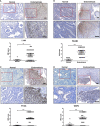Identification and analysis of novel endometriosis biomarkers via integrative bioinformatics
- PMID: 36339397
- PMCID: PMC9630743
- DOI: 10.3389/fendo.2022.942368
Identification and analysis of novel endometriosis biomarkers via integrative bioinformatics
Abstract
Endometriosis is a gynecological disease prevalent in women of reproductive age, and it is characterized by the ectopic presence and growth of the eutopic endometrium. The pathophysiology and diagnostic biomarkers of endometriosis have not yet been comprehensively determined. To discover molecular markers and pathways underlying the pathogenesis of endometriosis, we identified differentially expressed genes (DEGs) in three Gene Expression Omnibus microarray datasets (GSE11691, GSE23339, and GSE7305) and performed gene set enrichment analysis (GSEA) and protein-protein interaction (PPI) network analyses. We also validated the identified genes via immunohistochemical analysis of tissues obtained from patients with endometriosis or healthy volunteers. A total of 118 DEGs (79 upregulated and 39 downregulated) were detected in each dataset with a lower (fold change) FC cutoff (log2|FC| > 1), and 17 DEGs (11 upregulated and six downregulated) with a higher FC cutoff (log2|FC| > 2). KEGG and GO functional analyses revealed enrichment of signaling pathways associated with inflammation, complement activation, cell adhesion, and extracellular matrix in endometriotic tissues. Upregulation of seven genes (C7, CFH, FZD7, LY96, PDLIM3, PTGIS, and WISP2) out of 17 was validated via comparison with external gene sets, and protein expression of four genes (LY96, PDLIM3, PTGIS, and WISP2) was further analyzed by immunohistochemistry and western blot analysis. Based on these results, we suggest that TLR4/NF-κB and Wnt/frizzled signaling pathways, as well as estrogen receptors, regulate the progression of endometriosis. These pathways may be therapeutic and diagnostic targets for endometriosis.
Keywords: LY96; PDLIM3; PTGIS; TLR4/NF-κB; Wnt/frizzled; endometriosis; estrogen receptor.
Copyright © 2022 Bae, Jo, Cho, Jin, Kim, Shim, Kim, Park, Ryu, Lee, Joo and Ha.
Conflict of interest statement
The authors declare that the research was conducted in the absence of any commercial or financial relationships that could be construed as a potential conflict of interest.
Figures






References
Publication types
MeSH terms
Substances
LinkOut - more resources
Full Text Sources
Medical
Miscellaneous

